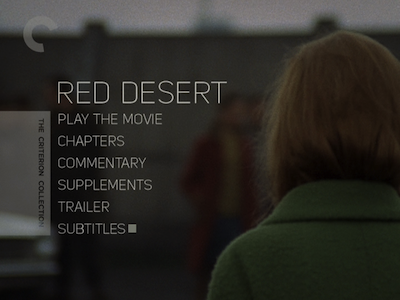
It's been maybe two years since I first saw Red Desert. It was shown in town as part of a festival of movies about how the environment was affecting individuals and often making them sick. I had never seen the film, it had long been out of print on DVD and I kept avoiding VHS copies thinking eventually someone would put out a quality re-release. Seeing it on a screen in a movie theatre was too good an opportunity to pass up. I even convinced a couple of friends to go with me. They weren't too happy with me by the end of it.
Part of their dissatisfaction likely came from the oblique nature of the movie. Michelangelo Antonioni's 1964 portrait of neuroses and malaise offers no explanations, it just plants the viewer down in the sticky mental muck and lets him or her untangle from the web. I would suspect, however, that most of their dissatisfaction came from the fact that what we watched was a horrible copy of the movie. I don't know if it was the old DVD projected or, as I suspected at the time, a digital file downloaded off the internet. Given the amount of pixilation and digital noise, it certainly wasn't a film print. It left me dissatisfied, too. Antonioni daring us to traverse his bleak cinematic landscape and find the meaning on the other side became too much to ask when also faced with a dark and murky image.
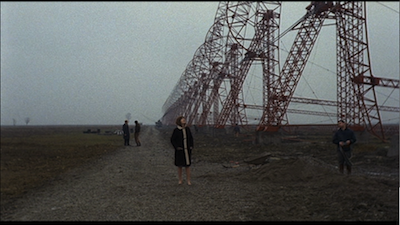
Oh, what a difference a good restoration makes! The newly minted transfer on the Criterion edition of Red Desert (Il deserto rosso) makes for an entirely different viewing experience. The widescreen image is crisply rendered, capturing the chilly aura of Antonioni and director of photography Carlo Di Palma's wasteland without sacrificing the heat of the bursts of color that occasionally dot the factory village where their story takes place. Midway through the film, when Monica Vitti spins a yarn about a little girl living alone on an island, the bright and beautiful interlude comes onto the television like the sun rising in the morning. The green of the foliage, the blue of the waters...it's just lovely.
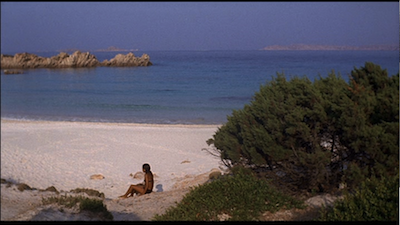
Apparently the original title of Red Desert was actually Pale Blue and Green. These are the colors of nature, and by their nature, the most soothing stripes on the rainbow. They suggest order, rightness, and calm. Though the title has a basis within the narrative--Monica Vitti's character, Giuliana, is considering them both for the interior of her proposed ceramics store, a safe haven she is creating for herself--the phrase didn't have the effect on audiences the director felt was required. Red Desert was more evocative. It is incendiary and barren.
Giuliana is a wife and mother. She is married to Ugo (Carlo Chionetti), a manager at an industrial factory, and their boy (Valeria Bartoleschi) is of kindergarten age. The Italian town where they live is reliant on the manufacturing plants it is built around, but as with any aspect of progress, the move forward comes at a price. Not only is there strife within the citizenry (we are presented with the dual problems of a worker's strike as well as there not being enough able-bodied men around), but it also creates a tremendous burden on the local ecology. For every good thing these factories presumably make, they also dump waste into the environment. On one side of a tree line there are the bustling signs of creation, on the other destruction and decay.

This is Giuliana's problem, as well. She is a woman at odds with herself. She was in a car accident that nearly killed her, and despite some recuperation time in the hospital, she has never been quite right since. There is something just a little off about her. Monica Vitti, who also starred in Antonioni's breakthrough pictures L'avventura [full review] and L'eclisse, avoids playing Giuliana as "crazy," but instead portrays her as a bundle of raw neuroses. She has the appearance of never being comfortable where she is, but also not knowing where else to go. She chews her nails, hides in her hair, and at any time looks like she is either going to cry or fall asleep.
Giuliana is a woman out of sync with her surroundings. Reading about Antonioni's intentions with Red Desert (he co-wrote the script with Tonino Guerra), he's not suggesting that the toxic environment is responsible for Giuliana's illness, but instead an active symptom of it. The smokestacks, hazardous sludge, and industrial grays and browns of her village are like a living metaphor for the disconnect she feels. While her husband and even her son have adapted to modern life, Giuliana has not. In her is something more primal, a need to get back to a basic humanity--the pale blue and the green. (If this sounds familiar, it's because it was the inspiration for Todd Haynes' film Safe

On a very basic level, Red Desert is the story of a love affair between Giuliana and a visiting business man who works with her husband. Corrado Zeller (Richard Harris, This Sporting Life [full review]) is a sort of nomad, traveling for work, following the money. He is out of sync, as well, but in a different manner. He is always moving and thus not tied down. He is like the water, whereas Giuliana is landlocked. Though Zeller will eventually express that he's not sure he's any better off for it, at least for a brief time, it at least makes him empathetic to Giuliana's problem. He settles long enough to hear her out, to listen to her complaints, and to seek out solutions.
There's a bit of opportunism in Zeller's kindness, however; for as much as he is trying to fix the wing of the wounded bird, he also ends up playing the jilted lover. Possibly because they are both separate from the rest, there is a magnetism between them, and they desire to connect on a sensual level that Ugo and his friends can only play at. In a crucial scene midway through Red Desert, Ugo and Giuliana join another married couple, along with a single woman of loose morals (Rita Renoir) and Zeller in a dockside shack where they circle around the idea of an orgy, but they never descend upon one another. It turns into a lot of posturing, who is sitting beside whom, etc. The whole scenario is a sad display of privilege. The shack belongs to one of the other man's employees, and this group uses it for what they will without permission. It's as if they need to slum in order to feel a thrill. Tellingly, they end up tearing down the interior walls to stoke their fire. They are literally destroying the structure just to keep themselves warm!
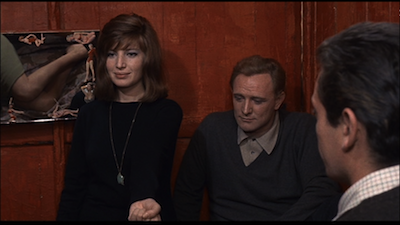
Events at this shack mark a point of no going back for Giuliana. Before the revelers depart, a ship comes to dock, sailing right up next to the house and startling her. (Does it, perhaps, remind her of the truck that nearly killed her?) That same ship also may be carrying a deadly contagion, and as the group flees possible infection, a heavy fog rolls in, separating Giuliana and Zeller from the others. It's a symbolic break, like the division between the factories and the land they are destroying. Giuliana is on one side of the malady, they are on the other.

Ships continue to appear throughout the rest of Red Desert, present in the background both visually and audibly, symbols of the escape Giuliana desires. The story she tells her son about the girl on the beach expresses this. (The girl's life has a true harmony. "Everything was singing.") She also tells Zeller a story about a woman she met in the hospital, who was there because she loved everything too much and thus could not accept that she must let any of it go. The natural flow of life continued onward, but she wanted to hold it back, to not change. Zeller correctly ascertains that Giuliana is speaking of herself, and this leads to a deeper understanding of what happened to her and also the greater meaning of Red Desert.

Though Antonioni appears to be painting with the same opaque brush throughout, anyone who understands paint knows there is no one color that is "white." There is no single, definitive "red." Antonioni's film is both narratively and visually complex. His sets are full of codes. Colors and shapes signal shifts in the psychological landscape as much as a torn-up field points out the side-effects of industry. When Giuliana finally makes a run for it, the hull of the ship she means to board is painted blood red--blood being both life and death and the confusion being which the ship offers. Shortly after, Giuliana sees yellow smoke belching from the stacks at her husband's workplace, and she tells her son it is poison. The color is another signal; the quarantine flag on the contaminated ship was also yellow. Yet, can we be sure the smoke is really yellow, or is that her perception? Did the sight of the red ship mark the border of her delusion, and she has now crossed over in the same way the fog drew a line between her and the "healthy" ones? There would be precedence for this, since Antonioni has already used sound as an outer expression of what is inside his heroine. Vittorio Gelmetti's electronic music for the film is unsettling, arising at times when Giuliana is the most discombobulated with the intention of drawing the viewer into her state of mind. Why shouldn't we be privy to her vision, as well?
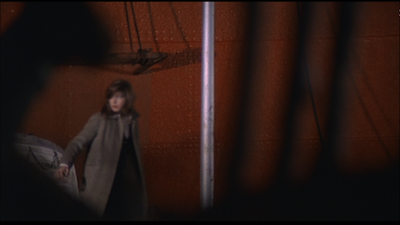
It is probably also fitting that Giuliana only wears her green coat at the beginning and the end of Red Desert, at the times when her psychoses are the most obvious to us yet when she is doing her best to mask them. It's as if she is wrapping herself in the warmth of nature. Of course, this is a subtle detail that is easy to miss when watching a bad version of the film. With a movie so finely tuned as this one, every detail has to be just right. What you see is the most important component, it provides all the subtext. If there is no difference between the green of Monica Vitti's coat, the red of her hair, and the gray of the sky, then it's all just pollution. Thus, I think even for devotees of Red Desert, this new DVD is going to be a real eye opener. Every detail of every frame is now visible, and as film fans, we can just sit back and let the movie work on us the way its makers intended.
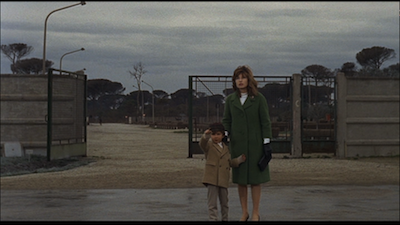
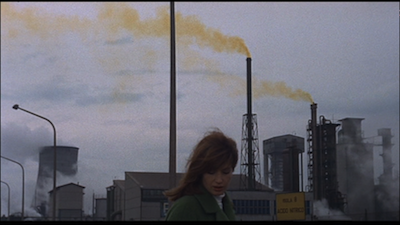
For a full rundown on the special features, read the full review at DVDTalk.

No comments:
Post a Comment